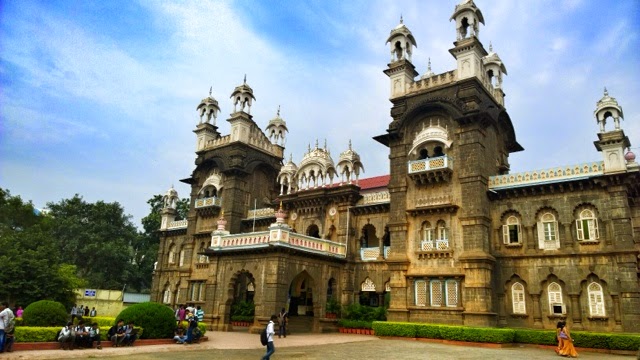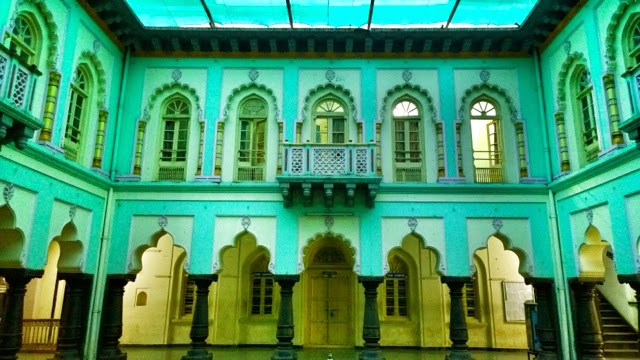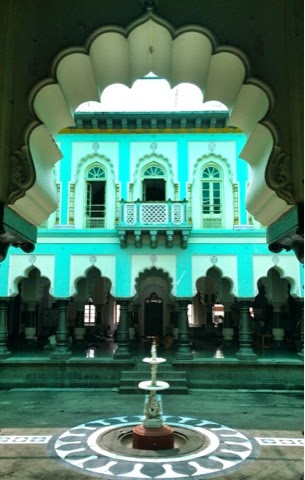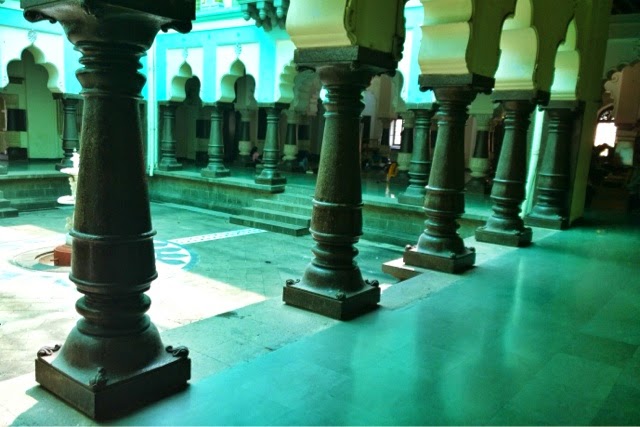Ichalkaranji, - things to do at the textile town near Kolhapur!
Ichalkaranji is a beautiful town in the Kolhapur District of Maharashtra and one of the things it's most famous for is the beautiful Rajwada or King's palace. The palace has now been converted into a university and keeps the gorgeous building well maintained and the heritage of the place alive.
Here is a short overview of the history of Ichalkaranj and it's Rajwada.
 |
| The gorgeous Rajwada from outside... |
The plan to visit Ichalkaranji was made just the evening before we left, and we visited the place purely on hunch and some hope. While I was looking forward to the visit, I was not prepared to come across this stunningly beautiful Rajwada of the Ghorpade dynasty.
We took more than four hours to reach here from Pune after a rather uneventful drive. Most of the day was spent meeting people and source materials, but I did manage to sneak some time out from the hectic schedule and explore the Rajwada.
All the pictures here are taken from Nokia Lumia 1020.
A Brief History
 |
| The coloured columns |
Historians who believe that the area has been inhabited since 4th Century BC. Due to its proximity to Kolhapur, it was later ruled by the Silahar Kindgom.
The name Ichalkaranji comes from the three villages were situated here in the 1700s - Ichy, Uchi and Karanji. As they expanded, they became one and that's how Ichalkaranji came into being. There is another theory as well about its name - the area had forests of karanji, and the tree gave the town its name. No one knows for sure which version is correct now, however, what we do know is that Naro Mahadev, the founder of the Ghorpade family, made Ichalkaranji his seat of power and that led to the rise of city.
The Ghorpade dynasty ruled Ichalkaranji for over two centuries till 1949, and it also has been credited for much of its growth and development even today. The city now boats of excellent sex ratio (way better than urban centres like Pune) and also of high literacy.
Rajwada of Ichalkaranji
 |
| The ample use of green make the place cool and inviting... |
The Rajwada came in to existence after the foundation of the city was laid and its in fairly pristine condition even now. A wada is a house in Marathi, and a Rajwada means a Royal house - this is where the royal family lived. With independence all the princely states joined the Indian union and Royalty came to an end. Most kings retained their ancestral palaces though only a few could afford to use them as their homes. Many converted them into heritage hotels, or sold them off. The king of Ichalkaranji decided to convert his royal household into a centre of higher education. Now the Rajwada houses an Engineering and Textile college.
The Rajwada is extremely well maintained even now. The numerous columns are well polished and the painted walls look new. And the palace is alive today with students walking through the corridors, working on assignments in the king's durbar or just hanging out with friends.
 |
| The courtyard! |
The architecture is very Maratha and you can even relate it to the Rajwadas in Pune and other Maratha centres of power across Maharashtra, where Shivaji lived. However, the overall structure is very European from outside. In fact, its a perfect blend of Indo European architecture which came to define the architecture of many princely estates in the late 19th and early 20th Centuries.
Ichalkaranji: Manchester of Maharashtra
Narayanrao Babasaheb Ghorpade is also credited with converting Ichalkaranji into a textile hub, so much so that its called the Manchester of Maharashtra now. Thanks to the textile industry, the city now boasts of one of the highest per capita income in India.
The city was also the first to get the power loom in India, which helped it develop rapidly.
Initially it was simply cotton, but now there many other weaves and fabrics that are made here, including twills, drills, demin and so on. Right from processing the raw material to dyeing, the city boasts of it all. There are some smaller stitching units as well here and often manufacture bags, uniforms etc. Now there are about 5000 odd textile units in this area alone!
How to reach Ichalkaranji?
We travelled by our own car from Pune, and the trip took us about four and half hours. On a bad traffic day it can take even longer. Kolhapur and Sangli two other centres which are very close by and extremely well connected by buses.
There are also buses from Pune which one can take, either directly to Ichalkaranji or first to Kolhapur or Sangli and then here.
 |
| Near the durbar hall... |
Nice article. Hope u tried the food over there its awesome :).
ReplyDeleteUnfortunately I didn't eat outside, but ate at my friends's place...
DeleteThis place is also famous for textiles. Did you get a chance to have a look at it?
ReplyDelete